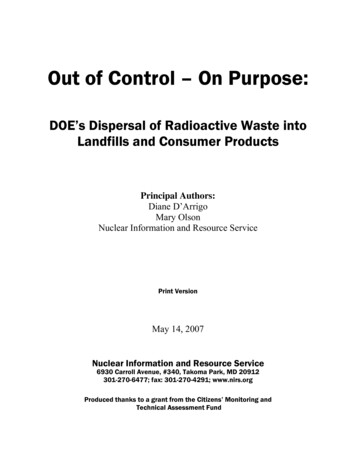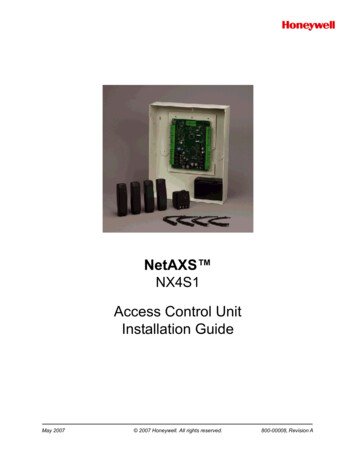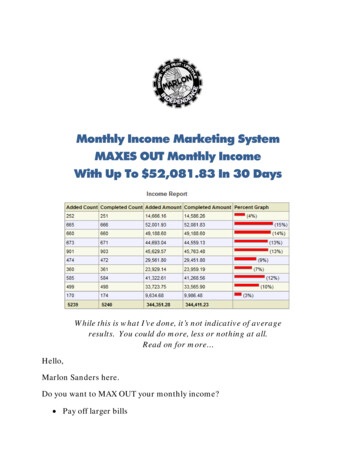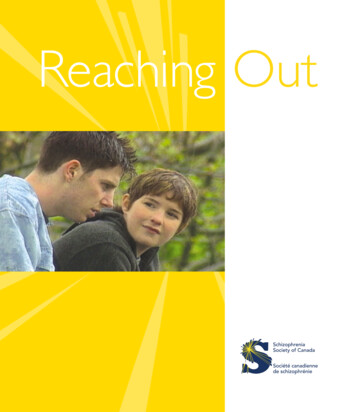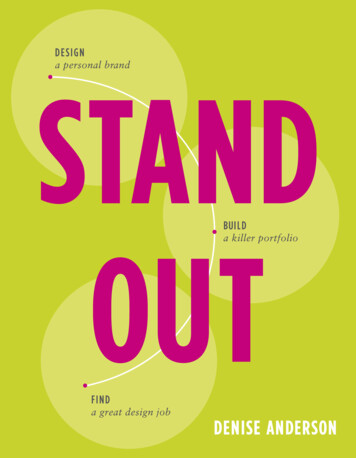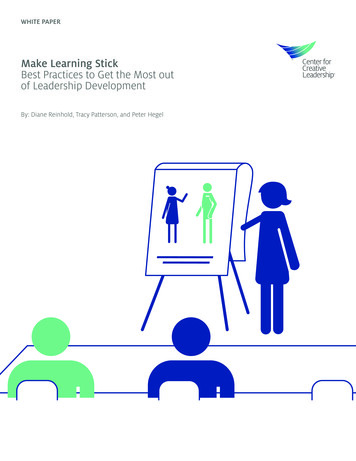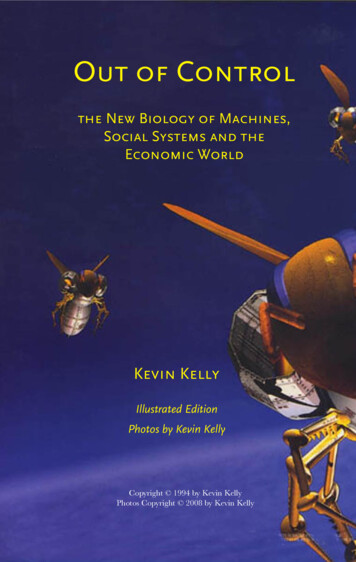
Transcription
Out of Controlthe New Biology of Machines,Social Systems and theEconomic WorldKevin KellyIllustrated EditionPhotos by Kevin KellyCopyright 1994 by Kevin KellyPhotos Copyright 2008 by Kevin Kelly
c o n t e n t s1The Made and the Born 6Neo-biological civilization 6The triumph of the bio-logic 7Learning to surrender our creations 82Hive Mind9Bees do it: distributed governance 9The collective intelligence of a mob 11Asymmetrical invisible hands 13Decentralized remembering as an act of perception 15More is more than more, it’s different 20Advantages and disadvantages of swarms 21The network is the icon of the 21st century 253Machines with an AttitudeEntertaining machines with bodies 28Fast, cheap and out of control 37Getting smart from dumb things 41The virtues of nested hierarchies 44Using the real world to communicate 46No intelligence without bodies 48Mind/body black patch psychosis 494Assembling Complexity 55Biology: the future of machines 55Restoring a prairie with fire and oozy seedsRandom paths to a stable ecosystem 60How to do everything at once 62The Humpty Dumpty challenge 6528585Coevolution67What color is a chameleon on a mirror? 67The unreasonable point of life 70Poised in the persistent state of almost falling 73Rocks are slow life 75Cooperation without friendship or foresight 786The Natural Flux 83Equilibrium is death 83What came first, stability or diversity? 86Ecosystems: between a superorganism and an identity workshopThe origins of variation 90Life immortal, ineradicable 92Negentropy 95The fourth discontinuity: the circle of becoming 9789
7Emergence of Control 99In ancient Greece the first artificial self 99Maturing of mechanical selfhood 102The toilet: archetype of tautology 104Self-causing agencies 1088Closed Systems 112Bottled life, sealed with clasp 112Mail-order Gaia 115Man breathes into algae, algae breathes into man 118The very big ecotechnic terrarium 120An experiment in sustained chaos 123Another synthetic ecosystem, like California 1309Pop Goes the Biosphere 133Co-pilots of the 100 million dollar glass ark 133Migrating to urban weed 136The deployment of intentional seasons 138A cyclotron for the life sciences 143The ultimate technology 14510 Industrual Ecology 147Pervasive round-the-clock plug in 147Invisible intelligence 149Bad-dog rooms vs. nice-dog rooms 151Programming a commonwealth 154Closed-loop manufacturing 155Technologies of adaptation 15811 Network Economics 161Having your everything amputated 161Instead of crunching, connecting 162Factories of information 165Your job: managing error 169Connecting everything to everything 17312 E-Money 176Crypto-anarchy: encryption always wins 176The fax effect and the law of increasing returns 182Superdistribution 184Anything holding an electric charge w ill hold a fiscal chargePeer-to-peer finance with nanobucks 195Fear of underwire economies 19613 God Games 198Electronic godhood 198Theories with an interface 199A god descends into his polygonal creationToThe transmission of simulacra 208Memorex warfare 209203189
Seamless distributed armies 213A 10,000 piece hyperreality 215The consensual ascii superorganismLetting go to win 21921614 In the Library of Form 221An outing to the universal library 221The space of all possible pictures 225Travels in biomorph land 228Harnessing the mutator 231Sex in the library 233Breeding art masterpieces in three easy stepsTunnelling through randomness 23923615 Artificial Evolution241Tom Ray’s electric-powered evolution machine 241What you can’t engineer, evolution can 245Mindless acts performed in parallel 247Computational arms race 251Taming wild evolution 253Stupid scientists evolving smart molecules 254Death is the best teacher 258The algorithmic genius of ants 261The end of engineering’s hegemony 26416 The Future of Control 267Cartoon physics in toy worlds 267Birthing a synthespian 269Robots without hard bodies 272The agents of ethnological architecture 275Imposing destiny upon free will 276Mickey Mouse rebooted after clobbering DonaldSearching for co-control 28127817 An Open Universe 283To enlarge the space of being 283Primitives of visual possibilities 284How to program happy accidents 285All survive by hacking the rules 288The handy-dandy tool of evolution 290Hang-gliding into the game of life 292Life verbs 294Homesteading hyperlife territory 29618 The Structure of Organized Change 300The revolution of daily evolution 300Bypassing the central dogma 302The difference, if any, between learning and evololution 304The evolution of evolution 307The explanation of everything 309
19 Postdarwinism310The incompleteness of Darwinian theory 310Natural selection is not enough 312Intersecting lines on the tree of life 314The premise of non-random mutations 315Even monsters follow rules 318When the abstract is embodied 320The essential clustering of life 321DNA can’t code for everything 322An uncertain density of biological search space 324Mathematics of natural selection 32520 The Butterfly Sleeps328Order for free 328Net math: A counter-intuitive style of math 329Lap games, jets, and auto-catalytic sets 331A question worth asking 333Self-tuning vivisystems 33721 Rising Flow 340A 4 billion year ponzi scheme 340What evolution wants 343Seven trends of hyper-evolution 346Coyote trickster self-evolver 35022 Prediction machinery352Brains that catch baseballs 352The flip side of chaos 355Positive myopia 357Making a fortune from the pockets of predictability 358Varieties of prediction 366Change in the service of non-change 369Telling the future is what the systems are for 370The many problems with global models 370We are all steering 37523 Wholes, Holes, and Spaces377What ever happened to cybernetics? 377The holes in the web of scientific knowledge 380To be astonished by the trivial 382Hypertext: the end of authority 385A new thinking space 38924 The Nine Laws of God392How to make something from nothing 392Annotated Bibliography398
1The Made and the BornNeo-biological civilizationI am sealed in a cottage of glass that is completely airtight. Inside I breathe my exhalations. Yet the air is fresh, blown by fans. My urine and excrement are recycled by asystem of ducts, pipes, wires, plants, and marsh-microbes, and redeemed into water andfood which I can eat. Tasty food. Good water.Last night it snowed outside. Inside this experimental capsule it is warm, humid,and cozy. This morning the thick interior windows drip with heavy condensation. Plantscrowd my space. I am surrounded by large banana leaves—huge splashes of heartwarming yellow-green color—and stringy vines of green beans entwining every verticalsurface. About half the plants in this hut are food plants, and from these I harvested mydinner.I am in a test module for living in space. My atmosphere is fully recycled by theplants and the soil they are rooted in, and by the labyrinth of noisy ductwork and pipesstrung through the foliage. Neither the green plants alone nor the heavy machines aloneare sufficient to keep me alive. Rather it is the union of sun-fed life and oil-fed machinerythat keeps me going. Within this shed the living and the manufactured have been unifiedinto one robust system, whose purpose is to nurture further complexities—at the moment, me.What is clearly happening inside this glasscapsule is happening lessclearly at a great scale onEarth in the closing yearsof this millennium. Therealm of the born—all thatis nature—and the realmof the made—all that ishumanly constructed—arebecoming one. Machinesare becoming biological and the biological isbecoming engineered.That’s banking onThe author in the sealed test capsule.some ancient metaphors.Images of a machine as organism and an organism as machine are as old as the first machine itself. But now thoseenduring metaphors are no longer poetry. They are becoming real—profitably real.This book is about the marriage of the born and the made. By extracting the logicalprinciple of both life and machines, and applying each to the task of building extremelycomplex systems, technicians are conjuring up contraptions that are at once both made
and alive. This marriage between life and machines is one of convenience, because, inpart, it has been forced by our current technical limitations. For the world of our ownmaking has become so complicated that we must turn to the world of the born to understand how to manage it. That is, the more mechanical we make our fabricated environment, the more biological it will eventually have to be if it is to work at all. Our future istechnological; but it will not be a world of gray steel. Rather our technological future isheaded toward a neo-biological civilization.The triumph of the bio-logicNature has all along yielded her flesh to humans. First, we took nature’s materials asfood, fibers, and shelter. Then we learned to extract raw materials from her biosphere tocreate our own new synthetic materials. Now Bios is yielding us her mind—we are takingher logic.Clockwork logic—the logic of the machines—will only build simple contraptions.Truly complex systems such as a cell, a meadow, an economy, or a brain (natural or artificial) require a rigorous nontechnological logic. We now see that no logic except bio-logiccan assemble a thinking device, or even a workable system of any magnitude.It is an astounding discovery that one can extract the logic of Bios out of biologyand have something useful. Although many philosophers in the past have suspected onecould abstract the laws of life and apply them elsewhere, it wasn’t until the complexityof computers and human-made systems became as complicated as living things, that itwas possible to prove this. It’s eerie how much of life can be transferred. So far, some ofthe traits of the living that have successfully been transported to mechanical systems are:self-replication, self-governance, limited self-repair, mild evolution, and partial learning.We have reason to believe yet more can be synthesized and made into something new.Yet at the same time that the logic of Bios is being imported into machines, the logicof Technos is being imported into life.The root of bioengineering is the desire to control the organic long enough to improve it. Domesticated plants and animals are examples of technos-logic applied to life.The wild aromatic root of the Queen Anne’s lace weed has been fine-tuned over generations by selective herb gatherers until it has evolved into a sweet carrot of the garden; theudders of wild bovines have been selectively enlarged in a “unnatural” way to satisfy humansrather than calves. Milk cows and carrots, therefore, are human inventions as much assteam engines and gunpowder are. But milk cows and carrots are more indicative of thekind of inventions humans will make in the future: products that are grown rather thanmanufactured.Genetic engineering is precisely what cattle breeders do when they select betterstrains of Holsteins, only bioengineers employ more precise and powerful control. Whilecarrot and milk cow breeders had to rely on diffuse organic evolution, modern geneticengineers can use directed artificial evolution—purposeful design—which greatly accelerates improvements.The overlap of the mechanical and the lifelike increases year by year. Part of thisbionic convergence is a matter of words. The meanings of “mechanical” and “life”are both stretching until all complicated things can be perceived as machines, and allself-sustaining machines can be perceived as alive. Yet beyond semantics, two concretetrends are happening: (1) Human-made things are behaving more lifelike, and (2) Life is
becoming more engineered. The apparent veil between the organic and the manufactured has crumpled to reveal that the two really are, and have always been, of one being.What should we call that common soul between the organic communities we know of asorganisms and ecologies, and their manufactured counterparts of robots, corporations,economies, and computer circuits? I call those examples, both made and born, “vivisystems” for the lifelikeness each kind of system holds.In the following chapters I survey this unified bionic frontier. Many of the vivisystems I report on are “artificial”—artifices of human making—but in almost every casethey are also real—experimentally implemented rather than mere theory. The artificialvivisystems I survey are all complex and grand: planetary telephone systems, computervirus incubators, robot prototypes, virtual reality worlds, synthetic animated characters,diverse artificial ecologies, and computer models of the whole Earth.But the wildness of nature is the chief source for clarifying insights into vivisystems,and probably the paramount source of more insights to come. I report on new experimental work in ecosystem assembly, restoration biology, coral reef replicas, social insects(bees and ants), and complex closed systems such as the Biosphere 2 project in Arizona,from wherein I write this prologue.The vivisystems I examine in this book are nearly bottomless complications, vastin range, and gigantic in nuance. From these particular big systems I have appropriatedunifying principles for all large vivisystems; I call them the laws of god, and they are thefundamentals shared by all self-sustaining, self-improving systems.As we look at human efforts to create complex mechanical things, again and againwe return to nature for directions. Nature is thus more than a diverse gene bank harboring undiscovered herbal cures for future diseases—although it is certainly this. Nature isalso a “meme bank,” an idea factory. Vital, postindustrial paradigms are hidden in everyjungly ant hill. The billion-footed beast of living bugs and weeds, and the aboriginal human cultures which have extracted meaning from this life, are worth protecting, if for noother reason than for the postmodern metaphors they still have not revealed. Destroyinga prairie destroys not only a reservoir of genes
6 1 The Made and the Born Neo-biological civilization I am sealed in a cottage of glass that is completely airtight. inside i breathe my exha- lations. yet the air is fresh, blown by fans. My urine and excrement are recycled by a system of ducts, pipes, wires, plants, and marsh-microbes, and redeemed into water and
